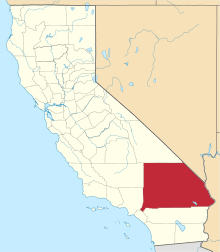Vanderbilt, California
| Vanderbilt | |
|---|---|
| Ghost town | |
 Vanderbilt Location within the state of California | |
| Coordinates: 35°19′38″N 115°14′59″W / 35.32722°N 115.24972°WCoordinates: 35°19′38″N 115°14′59″W / 35.32722°N 115.24972°W | |
| Country | United States |
| State | California |
| County | San Bernardino |
| Time zone | Pacific (PST) (UTC-8) |
| • Summer (DST) | PDT (UTC-7) |
| GNIS feature ID | 1661625 |
Vanderbilt was a short-lived gold mining town located in San Bernardino County, California, United States. It existed between 1893 and 1895. At its peak it may have had a population of about 400 people.
Location
Vanderbilt was located at 35° 19' 38.20" -115° 14' 59.14" (WGS84), which today is part of Mojave National Preserve.
History
In January, 1891, an Indian named Robert Black struck gold ore on the north slope of the New York Mountains, about 40 miles north of Goffs, California, on the Santa Fé Railway. A mining camp soon was established at nearby Vanderbilt Spring. The discovery of additional gold-rich veins in the fall of 1892 set off a rush to the area.
By January 1893, 150 people were living at Vanderbilt camp, which contained 50 tents, two stores, one saloon, three restaurants, a lodging house, a blacksmith shop, and a stable. A post office was established in February 1893. In May, W. A. Nash was appointed justice of the peace. Rail service to Manvel, five-miles to the south, commenced that August.
Vanderbilt probably reached its peak in 1894 with a population of about four hundred. The business district contained three saloons; two barbers; a Chinese restaurant and two other eating houses; two meat markets; a stationery and fruit store; one lodging house; two blacksmiths; and three well-stocked general stores. William McFarlane, one of the pioneers of Ivanpah, owned an interest in one of them, in which he ran the post office, and owned a drugstore.
According to Earp Historians, Virgil Earp, famed brother of Wyatt Earp who was also involved in the Gunfight behind the OK Corral, owned the only two-story building in this town. It operated as a hotel and saloon, and according to Allie Earp, Church services and Dances were also held inside.
During 1894 two ten-stamp mills were constructed to serve the two principal mines in the district, the Gold Bronze and Boomerang. At nearly the same time the mills were completed, water was struck in the mines. After hitting water, the character of the ore changed, and being unable to recover the gold in the ore, the mills were shut down. By the end of 1895 most businesses were closed and most of the population had abandoned Vanderbilt.
References
- Hensher, Alan (2005), "The Historical Mining Towns of the Eastern Mojave Desert", in Robert E. Reynolds editor, Old Ores, Mining History in the Eastern Mojave Desert, California State University, Desert Studies Consortium and LSA Associates, Inc., pp. 22–27
- Vredenburgh, L.M.; Shumway, G.L.; Hartill, R.D. (1981), Desert Fever, an overview of mining in the California Desert, living West Press: Canoga Park, CA
